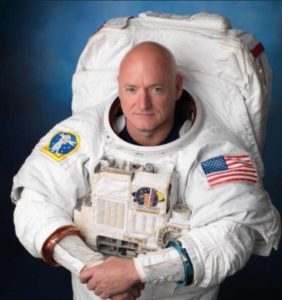
A new study conducted by NASA suggests that space travel may cause changes in genes and other biological markers in astronauts.
NASA scientists used Scott Kelly and Mark Kelly—two American astronauts and also identical twin brothers—in this study and observed genetic differences in them after completion of Scott Kelly’s space travel.
In 2015–16, American astronaut Scott Kelly spent 340 days on International Space Station (ISS). In total, he has spent 520 days in space during all his space missions. In comparison, Mark Kelly has spent 54 days during his four space-shuttle missions between 2001 and 2011. Because both brothers carry almost identical genomes, NASA collected blood and other biological samples from both brothers before and after Scott Kelly’s recent space mission to observe biological changes resulting from long-duration space missions.
The findings of the study revealed that there were changes in Scott Kelly’s gene expression, DNA methylation and other biological markers during his spaceflight. Scott’s telomeres (the caps on the ends of their chromosomes) also grew to be longer than his brother’s.
“That is exactly the opposite of what we thought,” said Susan Bailey, a radiation biologist at Colorado State University in Fort Collins.
The length of Scott’s telomeres returned quickly to pre-flight levels after his return to ground.
According to scientists, changes were also observed in microbiomes in the guts of two astronauts. It was also found that DNA methylation in Scott during his spaceflight, but increased in Mark over the same period. DNA methylation refers to the reversible addition of a chemical marker to DNA that can affect gene expression.
NASA is now conducting a separate study of telomere length in ten astronauts (unrelated to each other) to derive concrete conclusions. The study is expected to be completed in 2018, and is likely to shed more light on effect of spaceflight on telomeres.
“The greatest importance of the study is to show that we can do it,” explained Johns Hopkins University geneticist Andrew Feinbergi.
“I don’t think people realized it would be so easy to do genomics on astronauts in space.”
About NASA
Established in 1958, the National Aeronautics and Space Administration or NASA is the space agency of United States of America and is responsible for the civilian space program and aeronautics/aerospace research. Since being established in 1958, NASA has led US in its space exploration efforts, including the Skylab space station, the Apollo moon-landing mission, and Space Shuttle. NASA also shares its data with various national and international organizations.
In the past 50 years, NASA has carried out a variety of manned and unmanned spaceflight programs. Unmanned programs included launching the first American artificial satellites into Earth orbit, sending scientific probes to different planets such as Mars and Venus, and others. Manned programs included sending the first Americans into low Earth orbit (LEO), accomplishing successful human landing on Moon in 1969 through Apollo program, and developing semi-reusable LEO Space Shuttle and space station.
Currently, NASA is working in association with Russia and European Space Agency to manage the International Space Station. The agency is also overseeing the development of the Orion Multi-Purpose Crew Vehicle, Commercial Crew vehicles, and the Space Launch System.
